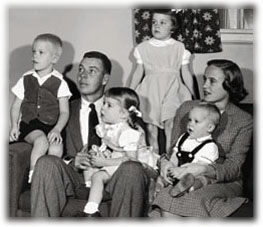Main Menu · Search ·Current Issue ·Contact ·Archives ·Centennial ·Letters to the Editor ·FAQs

 Lucian Brown, Minneapolis, ca. 1956 |
In 1956 you hire a professional photographer to leave his studio and come to your home with his large-format Speed Graphic camera to photograph your well-scrubbed family ensconced on the sofa watching TV. You ask a professional to capture your moment because the idiot-proof camera has not yet become available to you. You choose to pose your family in front of your television set perhaps because it is a new possession and you are pleased for yourselves. You do not imagine that half a century later the photograph will hang in an exhibition at Harvard. There it will mean something different to the people who see it than it means to you, which frequently is the case with photographs: they remain the same, but their meaning changes.
The Fifties were contented years for the generality of white, middle- and upper-middle-class Americans. They could afford to hire photographers to take pictures of the good life in progress. Here's mother in the kitchen with a new mixing appliance, baby being weighed on a nifty scale, the children learning to bow and curtsy at dancing school, mother and father spending the evening separately but together, junior striking a modified port-arms position, some innocent fun at the minstrel show.
Barbara Norfleet, senior lecturer emerita and curator of photography at the Carpenter Center for the Visual Arts, got a Radcliffe Ph.D. in social relations in 1951. She was one of the first photography curators anywhere to recognize the value as historical records of these "candids" by studio photographers. "They are visual social documents of the best kind, describing how the nonpoor in America wanted to see themselves and be remembered," she says. "Some of these images will speak to us today of racism, hedonism, arrogance, or bad taste, but they did not say this to the people who hired the photographer to take them. They were displaying themselves at happy times, at their best."
Norfleet began collecting these photographs for Harvard in 1972. Her acquisition technique was simply to go to studios across the country and ask to be given negatives. Many photographers obliged her. Along with images of family life came records of community activity (massed bathing beauties at the beach, businessmen bonding over a morning cup of coffee). Other photographs show the world of work (new Cadillacs, umbilical cords attached; props for a Sal Hepatica, Ipana, and Vitalis television advertisement). Still others reflect cataclysms of the day (a youngster receiving physical therapy for polio).
Exhibitions followed, as well as four books of photographs assembled by Norfleet: The Champion Pig, Killing Time, Wedding, and Looking at Death. So far, she has gathered about 2,500 prints and 40,000 negatives with contact prints. They comprise one of three parts of the Carpenter Center collection she oversees, the others being groups of 7,000 images documenting social reform in the United States from 1895 to 1910 and 2,500 examples of the work of art photographers since the invention of the medium.
She is now preparing an exhibition, yet to be scheduled, of 150 to 175 photographs dating from the end of World War II to 1960. The exhibition and accompanying book will combine words and images in what she intends to be powerful interplay. A timeline writ large will circle the gallery space, reminding us that 1946, for instance, saw the House Committee on Un-American Activities run closed hearings to investigate Communist subversion in films, the United Nations hold its first session, President Truman establish the Committee on Civil Rights, and Dr. Benjamin Spock deliver The Common Sense Book of Baby and Child Care.
Although the citizens appearing in these photographs may have felt pleased with life and complacent about their country, others, of course, saw the nation's problems and discontents. They complained, in writing, of racism, poverty, witchhunts, and alienation. "We did not want to face the underside of America's prosperity," says Norfleet, but the reckoning came. "The dissonance between criticism and image made the upheavals of the Sixties seem understandable."
She will pair each photograph in the exhibition with a telling quotation from a social critic who offers a view challenging the reality depicted. Three such pairings--concerning conformity, the military-industrial complex, and automobiles--appear in these pages, along with other photographs to be in the exhibition. The photographs are seen here by the general public for the first time.
[ Next page ]